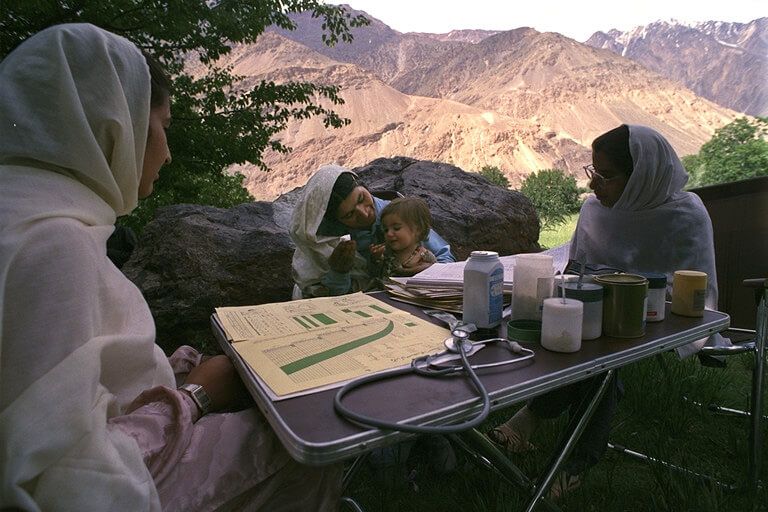Pakistan is in our thoughts this week as the country recovers from a devastating earthquake in western Baluchistan province. The remoteness of many affected communities from emergency services highlights their crucial need for resilience.

Health visitors conduct a growth monitoring session with a mother and child in Chitral, Pakistan.
In my recent trip to Pakistan, I learned more about the valuable work of the Chitral Child Survival Program (CCSP), funded by the U.S. Agency for International Development. It is another example of how the Aga Khan Development Network (AKDN) works through best practices, first on a focused scale, using innovation and experience to improve the health of vulnerable rural populations who lack access to basic health care. In this case, the communities are in Pakistan’s mountainous northern Chitral province, which has one of the worst mortality rates for mothers and children under age 5 in the country. So the Aga Khan Foundation (AKF) and the Aga Khan Health Service in Pakistan have trained scores of community midwives and the Aga Khan Rural Support Programme has fostered over 400 community savings groups to spur better local health-care options. (See our previous blog post depicting a story of the challenges and rewards faced by a young midwife as she settles into her community after recently graduating from AKF’s midwifery program.)
As the program moves into its final months, we look forward to it taking on another role: informing policy at the national level and beyond. From the start, the Chitral Child Survival Program was planned to inform a nationwide program for training midwives in Pakistan. To use lessons from the intensive Chitral experience for refining the national program, the program includes an operations research component.
One finding from earlier CCSP research that intrigued me even before my Pakistan trip involves this question: Is there a link between membership in a community-based savings groups and the local use of health-care services? It is often assumed that women who belong to savings groups are more likely to use that access to finance health services, but there are few studies to confirm or deny that assumption. Last year a survey conducted by CCSP looked at the use of health services by savings group members and compared that with non-members; they found that savings group members were significantly more likely to have used health-care services across the continuum of care.
There is much more we can learn from studies of this program’s first four years that can help to improve support for community health across Pakistan. Although I didn’t get to visit the Chitral midwives this trip, my visit to Pakistan helped to lay the groundwork for events in the coming year that I hope will showcase these lessons.
With our Aga Khan Foundation Pakistan colleagues, we plan to hold local/regional workshops that distill those experiences for the people of Chitral and recognize their work. We plan to have a national learning workshop in the capital, Islamabad.
The Chitral Child Survival Program may have impact beyond the borders of Pakistan as well. The U.S. Agency for International Development, which provided a generous grant for this program, plans to draw on replicable lessons to inform and strengthen the network of maternal and child health programs that it funds around the globe. In addition, Aga Khan Foundation offices in other countries will have the opportunity to present critical program lessons and experiences at international health conferences in Africa, Asia and North America.
You can learn more about the Chitral program and read a story from one of its savings group members in the 2012 annual report, which you can download here.
By David Hintch, Health Senior Program Officer for Aga Khan Foundation U.S.A.